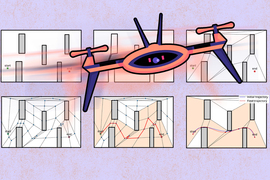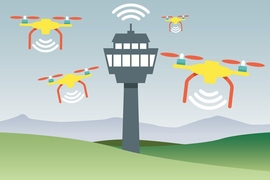How fresh are your data? For drones searching a disaster zone or robots inspecting a building, working with the freshest data is key to locating a survivor or reporting a potential hazard. But when multiple robots simultaneously relay time-sensitive information over a wireless network, a traffic jam of data can ensue. Any information that gets through is too stale to consider as a useful, real-time report.
Now, MIT engineers may have a solution. They’ve developed a method to tailor any wireless network to handle a high load of time-sensitive data coming from multiple sources. Their new approach, called WiSwarm, configures a wireless network to control the flow of information from multiple sources while ensuring the network is relaying the freshest data.
The team used their method to tweak a conventional Wi-Fi router, and showed that the tailored network could act like an efficient traffic cop, able to prioritize and relay the freshest data to keep multiple vehicle-tracking drones on task.
The team’s method, which they will present in May at IEEE’s International Conference on Computer Communications (INFOCOM), offers a practical way for multiple robots to communicate over available Wi-Fi networks so they don’t have to carry bulky and expensive communications and processing hardware onboard.
The study’s MIT authors are Vishrant Tripathi, Ezra Tal, Muhammad Shahir Rahman, Alexander Warren, Sertac Karaman, and Eytan Modiano of the Laboratory for Information and Decision Systems (LIDS), along with Igor Kadota SM ’16, PhD ’20 at Columbia University.
Last in line
The team’s approach departs from the typical way in which robots are designed to communicate data.
“What happens in most standard networking protocols is an approach of first come, first served,” Tripathi explains. “A video frame comes in, you process it. Another comes in, you process it. But if your task is time-sensitive, such as trying to detect where a moving object is, then all the old video frames are useless. What you want is the newest video frame.”
In theory, an alternative approach of “last in, first out” could help keep data fresh. The concept is similar to a chef putting out entreés one by one as they are hot off the line. If you want the freshest plate, you’d want the last one that joined the queue. The same goes for data, if what you care about is the “age of information,” or the most up-to-date data.
“Age-of-information is a new metric for information freshness that considers latency from the perspective of the application,” Modiano explains. “For example, the freshness of information is important for an autonomous vehicle that relies on various sensor inputs. A sensor that measures the proximity to obstacles in order to avoid collision requires fresher information than a sensor measuring fuel levels.”
The team looked to prioritize age-of information, by incorporating a “last in, first out” protocol for multiple robots working together on time-sensitive tasks. They aimed to do so over conventional wireless networks, as Wi-Fi is pervasive and doesn’t require bulky onboard communication hardware to access.
However, wireless networks come with a big drawback: They are distributed in nature and do not prioritize receiving data from any one source. A wireless channel can then quickly clog up when multiple sources simultaneously send data. Even with a “last in, first out” protocol, data collisions would occur. In a time-sensitive exercise, the system would break down.
Data priority
As a solution, the team developed WiSwarm — a scheduling algorithm that can be run on a centralized computer and paired with any wireless network to manage multiple data streams and prioritize the freshest data.
Rather than attempting to take in every data packet from every source at every moment in time, the algorithm determines which source in a network should send data next. That source (a drone or robot) would then observe a “last in, first out” protocol to send their freshest piece of data through the wireless network to a central processor.
The algorithm determines which source should relay data next by assessing three parameters: a drone’s general weight, or priority (for instance, a drone that is tracking a fast vehicle might have to update more frequently, and therefore would have higher priority over a drone tracking a slower vehicle); a drone’s age of information, or how long it’s been since a drone has sent an update; and a drone’s channel reliability, or likelihood of successfully transmitting data.
By multiplying these three parameters for each drone at any given time, the algorithm can schedule drones to report updates through a wireless network one at a time, without clogging the system, and in a way that provides the freshest data for successfully carrying out a time-sensitive task.
The team tested out their algorithm with multiple mobility-tracking drones. They outfitted flying drones with a small camera and a basic Wi-Fi-enabled computer chip, which it used to continuously relay images to a central computer rather than using a bulky, onboard computing system. They programmed the drones to fly over and follow small vehicles moving randomly on the ground.
When the team paired the network with its algorithm, the computer was able to receive the freshest images from the most relevant drones, which it used to then send commands back to the drones to keep them on the vehicle’s track.
When the researchers ran experiments with two drones, the method was able to relay data that was two times fresher, which resulted in six times better tracking, compared to when the two drones carried out the same experiment with Wi-Fi alone. When they expanded the system to five drones and five ground vehicles, Wi-Fi alone could not accommodate the heavier data traffic, and the drones quickly lost track of the ground vehicles. With WiSwarm, the network was better equipped and enabled all drones to keep tracking their respective vehicles.
“Ours is the first work to show that age-of-information can work for real robotics applications,” Tal says.
In the near future, cheap and nimble drones could work together and communicate over wireless networks to accomplish tasks such as inspecting buildings, agricultural fields, and wind and solar farms. Farther in the future, he sees the approach being essential for managing data streaming throughout smart cities.
“Imagine self-driving cars come to an intersection that has a sensor that sees something around the corner,” Karaman says. “Which car should get that data first? It’s a problem where timing and freshness of data matters.”










